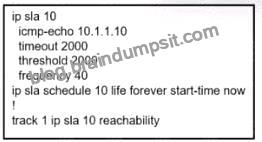NEW QUESTION 122
Refer to the exhibit.

An engineer configured IP SLA to monitor a next hop on a router for reachability When the next hop is unreachable, the router is executing tracking and failing over another route, but packet loss is experienced because the reachability is flapping. Which action resolves the issue?
IP SLA (Internet Protocol Service Level Agreement) is a feature that allows you to measure network performance such as latency, jitter, packet loss, and so on. In this case, it’s being used to monitor the reachability of a next hop on a router123.
When the next hop is unreachable, the router is executing tracking and failing over to another route. However, packet loss is experienced because the reachability is flapping. This could be due to the router switching back and forth between the primary and backup routes too quickly.
To resolve this issue, you can introduce a delay in the tracking process. This can be done by appending a delay to the track command. Option C suggests appending a delay of 50 seconds for the up state and 60 seconds for the down state45. This means that the router will wait for 50 seconds before declaring the tracked object as up (reachable) and 60 seconds before declaring it as down (unreachable). This delay can help prevent the router from switching routes too quickly, thus reducing the chances of reachability flapping and packet loss45.
References:
* Configure ISP Failover with Default Routes Using IP SLA Tracking – Cisco
* Using IPSLA to change routing – Cisco Community
* How to Use IP SLA Technology to Assess WAN Performance
* Reliable Static Routing with IP SLA – NetworkLessons.com
* Configuring Static Route Tracking using IP SLA (Basic)
